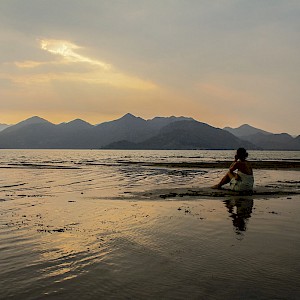The largest lake on the Balkan Peninsula
The largest lake on the Balkan Peninsula and also the only national park dominated by aquatic and wetland ecosystems.
Location and places
Picturesque and unique in many ways, Skadar lake nests in Zeta-Skadar valley, keeping contact with Bojana River to the Adriatic Sea, which was separate from Adriatic sea with a chain of high mountains in the distant past.
It consists of six parts: Large mud, Little mud, Wolf’s mud, flooded valley of Crnojevica River, bay and basin Hotski. However, Drim River is responsible for the current size of the Lake. In year 1858. there was such a great storm in which the Drim River has become crazy. That storm washed away much of the sludge and oodles of earth from the Albanian mountains has accumulated at the delta of the river Bojana, so it has moved its course and flooded the barn, and morass has become a lake - the largest lake on the Balkan Peninsula.
The lake lays on the border between Montenegro and Albania. Montenegro is 60% of the lake while the other 40% lays on the territory of the Republic of Albania. The Montenegrin part of the Lake area is about of 40,000 ha with an area of 370 to 530 km2 (square kilometers), depending of water-level.
The lake is in cryptodepression state, which means that some parts of its bottom is below sea level.

Such places are called Eyes. There are about 30 of them. The deepest is Radus Eye, 60 meters deep, and according to some data, and deeper, while the lake's average depth of about 6 m. It was established 1983. as National Park. Its coasts are indented with numerous bays, peninsulas and forelands, mostly marshed, overgrown with reeds.
Flora and fauna
Flora is rich and varied. As an important habitat for water birds, Skadar Lake were enrolled in the World List of Ramsar Wetlands of International Importance by a Ramsar Convention in 1996. Due to the preservation of the ecosystem mainly and due to the inaccessibility of some parts of the lake, especially along its northern coast swampy lake, it is a paradise for birds, 264 species of birds, many of which are in most of its range, thinning and vulnerable.
In Europe, a rare Dalmatian Pelican (Pelecanus crispus) is a symbol of the Lake. In the park there are living 48 species of fish, 50 species of mammals (the only representative of the water is otter), numerous amphibians, reptiles and insects. A diverse plant life, both in the lake as well as its environment, and in the summer months, water lilies and water meadows of nuts, may be outspread for miles.
Archaeological localities
Skadar Lake has a rich history and culture, evidenced by numerous archaeological localities, medieval monasteries and churches, fortresses and folk architecture (fishing villages, old bridges, mills and wells). The extraordinary group of cultural heritage make the traditional buildings, old unpopulated and deserted fishing village, situated on the coast of the Lake: Radus, Krnjice, Poseljani and Karuc, which were populated once in not very distant past and where people lived by fishing and knitting out fishing nets.
Climate
Climate: Sub-Mediterranean, with mild, rainy winters (the lowest monthly average temperature of water in January is 7.3 ° C). The summers are dry and hot with maximum air temperature above 40 ° C and a water temperature above 27 º C. The average temperature is 14.9 º C.








